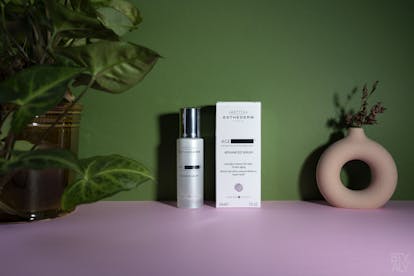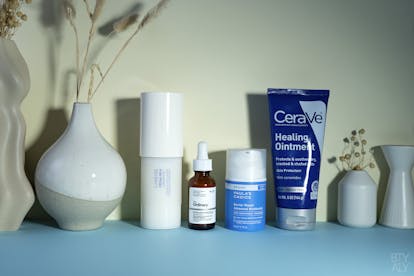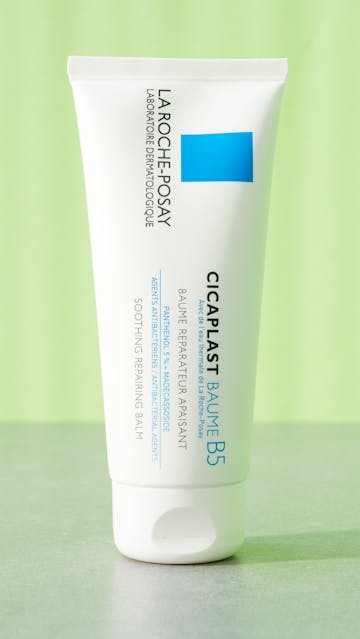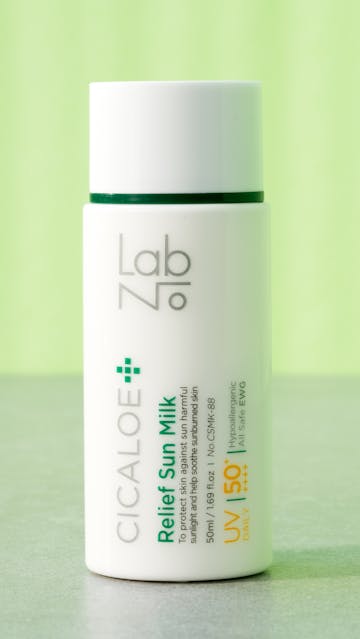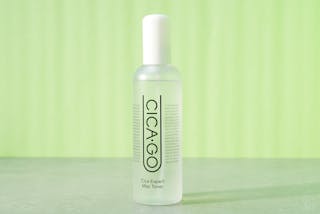At a glance
An introduction to the star cosmetic ingredient at the moment: Centella Asiatica, plus an overview of the “cica” trend with several product examples.
A huge trend in Korea, Centella Asiatica-based “cica” products are absolutely everywhere at the moment. Today, let’s focus on this ingredient adored by sensitive skins!
In France in 2017, two out of three women reported having sensitive skin. You can find similar reports in the rest of the world: the number of people experiencing symptoms of sensitive skin (redness, burning sensations, tingling, etc.) has been constantly increasing in recent years.
In 2016, a Mintel study in the UK showed that nearly a third of consumers aged 16 to 25 considered themselves to have a sensitive skin. In 2017, another study revealed that up to half of American women also claimed to have sensitive skin and were looking for safer and softer cosmetic products. Finally, according to Mintel, one-third of the skincare products launched in South Korea in 2017 were for sensitive skin, demonstrating a significant increase in demand in this market.
This is mostly due to the pollution (particularly the one caused by fine dust, which is particularly devastating for the skin), an increasingly stressful lifestyle and the use of cosmetic ingredients that are certainly very effective but can be too harsh for some skin types (acids, retinol, etc.).
Consequence: the cosmetic ingredients able to soothe sensitive skins are booming! And especially ancient herbal formulas used in traditional Asian medicines to soothe and heal wounds, which are also very effective on sensitive skins.
And among these rediscovered natural extracts, Centella Asiatica is undoubtedly the most popular ingredient at the moment for sensitive skin!
What is Centella Asiatica:
Centella Asiatica (or Gotu Kola) is a plant found mainly in tropical and subtropical countries such as Madagascar, South Africa, Indonesia, but also in India, China, and the Korean peninsula. It’s also called Tiger grass because these big cats roll spontaneously in it to heal when they have wounds or itches.
Centella Asiatica is part of the botanical family of Apiaceae. In cosmetics’ formulas, it’s mainly its leaves and stems that are used.
Used in Ayurvedic medicine for over 2,000 years for its regenerative and healing properties, Centella Asiatica is known to heal wounds and soothe skin lesions.
In Asia, there are many legends about the healing properties of Centella Asiatica. One of them tells how a young peasant in Laos fell in love with the daughter of the village chief. When he proposed, the father of the young lady, finding the condition of the suitor far too modest, became angry and cut the peasant’s ear with his sword. Yes, at the time, if you tried to marry someone with a higher social condition than yours, you exposed yourself to very serious trouble. It was no joke!
But the village chief decided to humiliate the young suitor even more. In the village, the young peasant had the reputation of being a healer. The village chief challenged him and told him that he could marry his daughter on one condition: he had to come back the next day with his ear completely healed. The young peasant knew the properties of Centella Asiatica, because he had often seen tigers rolling in this grass to heal their wounds.
So he spent the whole night applying tiger grass to his ear and presented himself the next morning in front of the village chief with his healed ear. The marriage happened and the legend of Centella Asiatica began to spread.
It should be noted that in this legend, the lady had no say in the matter, but this is a whole other story…
The benefits of Centella Asiatica on the skin:
In cosmetics, it is mainly the leaves and the stems of Centella Asiatica that are used. These contain two families of ingredients with known benefits for the skin:
– saponins: madecassoside and asiaticoside,- triterpenes: asiatic acid and madecassic acide.
All these components have healing, antibacterial, regenerative and antioxidant properties. In addition, they also have the ability to increase collagen production and they strengthen the skin barrier. Centella Asiatica is therefore an effective repairing and anti-aging ingredient to prevent and reduce fine lines and wrinkles.
The “cica” trend:
In recent years, driven by a huge craze in South Korea, the “cica” cosmetics trend is everywhere! In the shops, you see “cica” creams, “cica” serums, “cica” toners, even “cica” shampoos and hair masks.
Let’s take a step back about this trend!
Starting with some of the vocabulary. There are two possible explanations for the origin of the word “cica”:
The “cica” products could take their name from their high concentration in Centella Asiatica. It could be a word created with Centella’s “c” and Asiatica’s “-ica”.
But another explanation would be that the name of this trend comes from the French word “cicatriser” (which means healing).
Indeed, before Korean “cica” products became super popular, many French pharmacy brands already offered ointments and creams using Centella Asiatica to help repair skin lesions and treat scars.
If you’re French, you probably already know them, they are must-haves in the French bathrooms to treat small skin lesions: balms and creams like Cicaplast by La Roche Posay, Cicalfate by Avene, Cicabio by Bioderma etc.
Many of these products contain Centella Asiatica, or one of its derivatives in their formula, but not all of them. With these products, the main goal is to accelerate the healing process, so they also use ingredients like vitamin B5 (or panthenol) as well as copper and zinc extracts that have similar properties to Centella Asiatica.
These products are usually applied on an injury, once the wound is closed, to help the skin heal better and faster.
French “cica” products are available in several forms: balms, creams, lotions, healing sun creams… As a general rule, they are intended for a small topical use. They aren’t designed to be used on the entire face, for example (although there are more and more variations of “cica” products nowadays. Because the trend is very popular at the moment, the number of “cica” products is increasing all over the world, including France).
The Korean version of the “cica” products is a little bit different.
Where the “cica” French products have an almost medical and above all very targeted approach (you use them on a small part of the skin), the “cica” Korean products are for a more global skincare approach and they’re rather intended to be used on the entire face.
Korean “cica” products refer to a whole range of soft products, designated for sensitive skin, with repairing properties but more in the sense of anti-aging cell regeneration. It’s not really a “dermatological” approach like the French “cica” healing products.
That being said, the Korean “cica” ranges tend to flirt with this dermocosmetic approach, which they convey through packagings that often look like pharmaceutical ointments.
Indeed, from a marketing point of view, the integration of this concept of “derma-science” as well as the use of a natural ingredient (the Centella Asiatica) is very positively considered by consumers, especially if they have a sensitive skin and if they want to be reassured with products that convey an image of safety and efficiency.
The Korean choice of “cica” products is also much wider than French “cica” products. The first “cica” creams quickly evolved into new textures. There are now “cica” serums, toners, masks, cleansers, sheet-masks, etc. But also “cica” products for the body, hair and hands!
It’s simple, the craze is such that in South Korea at the moment, almost every new skincare release is “cica”!
The “cica” products are for me if:
– My skin is damaged and I want it to heal faster:
The “cica” French creams available in pharmacies are the ideal candidates in the case of a damaged skin, and this, for the whole family (even infants). (ex: Cicaplast by La Roche Posay, Cicalfate by Avene, Cicabio by Bioderma etc)
They relieve all kinds of skin problems: burns, scratches, itches, mosquito bites, chapped skin, sunburn, irritated nose in case of colds, scabs, diaper rash, damaged feet, chicken pox scars, but also damage caused by aesthetic procedures such as tattooing, peeling or laser, and of course, they are also ideal for scars caused by surgery.
I always have a tube in my bathroom (I stock some every time I go back to France).
– I have a sensitive skin:
The Korean (or Korean-inspired) “cica” ranges are designed to relieve redness, burning sensation, and tightness for sensitive skin. They soothe right away and they also have the properties of strengthening the skin barrier for a more resistant skin to external aggressions.
You can add a “cica” serum to your routine for a soothing effect, a toner for an immediate relief and refreshing feeling (if it’s a mist, it’s even better!) and/or opt for a cream if you need more protection.
– My skin is acne prone:
“Cica” products are perfect to calm the inflammation of the acne-prone skins and to help lesions (= pimples) to heal faster and more evenly.
You can use a “cica” cream directly on the pimple or a “cica” serum all over your face for a soothing and repairing effect.
– I live in a very polluted environment:
Pollution has very damaging effects on the skin:
– dehydration,
– dryness and desquamation disorders (= the skin begins to peel),
– dull complexion, clogged pores,
– redness,
– burning sensation, tingling,
– eczema,
– accelerated skin aging…
“Cica” products such as serums or creams help to calm sensitivity but also to strengthen the skin barrier for a more resistant skin against aggressions from pollution, such as fumes, fine dust etc.
– I’m using sensitizing skincare treatments (acids, retinol):
Some active ingredients are very effective in preventing and treating the signs of aging but can be irritating to the skin. Retinol or acids, for example, can cause redness, irritation and flaking, especially if you overuse them.
“Cica” products such as serums or creams also have a calming effect and will help to strengthen the skin barrier, for a more resistant skin, which regenerates quickly (so the skin has a younger appearance, as a bonus!).
– I want to use anti-aging properties in my cosmetics:
Centella Asiatica is supposed to have a boosting effect on collagen production. So you can add a “cica” serum to your routine to prevent and treat fine lines and wrinkles.
A few examples of “cica” products:
Uriage Bariéderm:
Uriage is a French dermo-cosmetic brand, which uses the virtues of thermal water to soothe sensitive skins. There is a whole range of products for the healing, repairing, and protection of damaged skin at Uriage, the Bariéderm range.
The cream Bariéderm is the typical example of a “cica” product that doesn’t contain Centella Asiatica. The repairing and healing effect is obtained here thanks to vitamin B5 (panthenol), Copper and Zinc also provide an anti-bacterial effect. It’s the ideal product to apply to an area of damaged skin to help it repair and heal faster.
It’s available in a classic cream version,
and also in a sunscreen , that you can apply on the damaged area for a repairing but also protective effect against UV rays (it’s better to avoid the sun when you have a fresh scar).
Bioderma Cicabio:
Bioderma is also a French dermo-cosmetic brand, specialized in products for sensitive skins. Their Cicabio range is designed to repair the epidermis. It includes several types of products designed to protect the skin but also to help the skin healing process.
The is a healing cream, that you can apply to an area of damaged skin to help it to heal faster.
It contains Centella Asiatica, but also other repairing and antibacterial ingredients such as copper and zinc. It also provides hydration with hyaluronic acid.
In this category of products, it’s one of my favorites, especially because it has a fairly light texture and protects the damaged skin area without leaving a very thick and greasy film (but it also exists in a balm version if you prefer a more occlusive effect). I use it a lot on the corners of my lips because they get irritated and dry quite easily.
La Roche Posay Cicaplast:
La Roche Posay is, like Uriage, a French dermo-cosmetic brand that uses the virtues of thermal water to soothe sensitive skin. Their healing and skin protection range is called Cicaplast.
The best-seller of this range is the , a real rockstar in French pharmacies.
It’s also a product that repairs and accelerates healing but its balm texture is very appreciated because it can easily be used on very sensitive and drier areas of the face, lips or even the body. It’s a very versatile product.
In this balm, you can find repairing ingredients such as madecassoside (derived from Centella Asiatica) and panthenol (vitamin B5), but also purifying and anti-bacterial components (copper and zinc) and moisturizing ones (shea butter and glycerin) for skin comfort.
Cosrx Centella:
Cosrx is a Korean brand that could be described as dermo-cosmetic. Very minimalist packaging, simple and targeted products with natural ingredients known for their effectiveness, and all that at a very reasonable price.
Cosrx is for me the archetype of the simple but effective skincare brand! It’s one of my favorite Korean ranges and I’m delighted that they’re becoming easier to find online.
Their Centella range is designed for acne prone skins, with a high concentration in Centella Asiatica derivatives, for a soothing and healing effect very beneficial on problem skins.
The is a very pleasant product to use just after you’ve cleansed your face, to soothe the skin and prepare it to receive the rest of your skincare routine.
It’s in a mist format and is composed of 82% mineral water from Jeju Island (South Korea) and 10% water from Centella Asiatica leaves. It’s a very soft and soothing product (I love it especially in summer, for its refreshing effect).
The is ideal for more in-depth treatment.
Its high water concentration of Centella Asiatica leaves (85%) helps to calm inflammation of acne-prone skin while also strengthening the skin barrier to prevent future pimples. It also contains moisturizing ingredients such as hyaluronic acid and other calming ones such as allantoin and betaine.
Cicago:
Cicago is a new Korean natural dermo-cosmetic skincare brand, dermatologist tested and cruelty-free. The brand specifically targets sensitive skins by using Centella Asiatica as the main ingredient in their products.
In Cicago products’ formulas, natural ingredients play a major role, but the brand doesn’t, however, set aside other high-performance and innovative scientific ingredients.
The “non-toxic” communication of the brand isn’t really my cup of tea but I still think that the brand concept is interesting. In any case, Cicago is super popular in Korea and the products are often out-of-stock!
The range is very short for the moment, with only 6 products available. My husband went to Korea last month and brought me 3 Cicago products, which I haven’t tried yet but I still want to introduce them to you.
This product is definitely the star of the range! This treatment (which can be considered as a serum) helps to rebalance the skin, taking care of its hydration while helping the skin to repair itself from the damage caused by everyday stress factors (climate, pollution, stress…).
The Centella Asiatica and vitamin B5 (panthenol) the ampoule contains, help to reduce irritation and redness. In its list of ingredients, there is also arbutin that helps to lighten brown spots and hyperpigmentation to reveal the skin’s natural radiance. There are also various natural oils such as squalane or Macadamia seed oil…
As an example, here is the complete ingredients list and you’ll see right away why I’m looking forward to using it!
Water, Glycerin, Cetyl Ethylhexanoate, Squalane, Arbutin, Sodium Chloride, Sericin, Cnidium Monnieri Fruit Extract, Viscum Album (Mistletoe) Extract, Chamaecyparis Obtusa Leaf Extract, Macadamia Ternifolia Seed Oil, Panthenol, Centella Asiatica Extract, Citrus Aurantium Bergamia (Bergamot) Fruit Oil, Scutellaria Baicalensis Root Extract, Paeonia Suffruticosa Root Extract, Glycyrrhiza Uralensis (Licorice) Root Extract, Xanthan Gum, Sorbitan Sesquioleate, Castanea Crenata (Chestnut) Shell Extract, Salix Alba (Willow) Bark Extract, Melia Azadirachta Leaf Extract, Melia Azadirachta Flower Extract.
A soothing and refreshing mist toner, for an immediate refreshing effect, perfect for irritated skin!
The composition is also impeccable, filled with natural ingredients.
A moisturizing and soothing cream to protect the skin from daily aggressions.
Once again, the composition is super appealing to me and I will probably have the opportunity to talk to you about it again in a more detailed review once I’ve tried it.
Dr Jart+ Cicapair:
Dr Jart+ is a Korean brand with a dermo-cosmetic inspiration that works closely with a team of dermatologists but also with innovation experts (artists, designers, and various other technophiles) who allow them to have access to cutting-edge technologies in several fields.
Dr. Jart+ products are manufactured with the highest scientific rigor, and the product designs are modern and refined. This combo of a very serious medical approach and an ultra trendy aesthetics is extrememy popular at the moment!
Cicapair is the Dr Jart+ range based on Centella Asiatica. It includes several different skincare products, including the , a soothing balmy cream for rather dry to sensitive skins.
It contains many repairing ingredients including a complex of Centella Asiatica (with the 4 derivatives of this herb: madecassoside, asiaticoside, asiatic acid and madecassic acid) but also other healing herbs (including Houttuynia Cordata), and a solution of minerals and vitamin B5 (panthenol) for a soothing and regenerating effect.
This one is used by my husband because his skin is much drier than mine. It has a rather “balmy” texture that is probably not the best for combination or oily skin (or else, only in small areas of skin, but I find it a little bit expensive for only this use and I would tend to recommend the ones from the French pharmacy brands I mentioned earlier).
A’Pieu Madecassoside:
A’Pieu is a Korean cosmetics brand specialized in trendy beauty products (skincare and makeup). The overall concept of this brand is quite complicated to summarize because when you enter an A’Pieu shop, you almost feel like there are several brands in the shop, because the product ranges are so different from each other (a bit like Missha, which also belongs to the same cosmetic group). You could say that the brand identity is not very harmonious.
The prices are very affordable and the launches are very frequent with new products that are often released for the Korean customers eager for newbies.
The Madecassosside range is a best-seller one. It includes about ten different products, designed for sensitive and acne-prone skins.
The must-have of the range, very often out-of-stock, is the , a soothing cream composed of 40% Centella Asiatica extract and 0.1% Madecassoside, among other ingredients, so it’s very soothing.
Compared to the Dr. Jart+ Cicapair cream I mentioned earlier, according to my husband who used it for much of last year, the texture of the A’Pieu Madecassoside Cream is much lighter. It’s also very moisturizing but without the heavier texture that the Dr Jart+ cream has.
The composition is not the most natural. It certainly contains many plant extracts but also a lot of silicone derivatives.
I think the A’pieu Madecassoside Cream is more suitable for sensitive skins looking for a protective and moisturizing product but with a preference for lighter textures during the day, for example. Its big plus over the Dr Jart+ one is also the price. It retails for less than $10.
Labno Cicaloe:
Labno is a brand new Korean brand. In fact, it’s so new that I had a hard time finding any information about it!
 SkincareAn overview of 3 Korean sunscreens (feat. make p:rem, Labno and Etude House)
Today, I tell you more about 3 Korean sunscreens I recently tried, the make p:rem UV defense me Blue ray sun gel, the Labno Cicaloe Relif Sun Milk, and the Etude House Sunprise Mild Airy Finish.
Read more
SkincareAn overview of 3 Korean sunscreens (feat. make p:rem, Labno and Etude House)
Today, I tell you more about 3 Korean sunscreens I recently tried, the make p:rem UV defense me Blue ray sun gel, the Labno Cicaloe Relif Sun Milk, and the Etude House Sunprise Mild Airy Finish.
Read more
I was first interested in it because some Korean beauty bloggers I’m following highly recommend their products, so I asked my husband to bring me some of them to try while he was in Korea last month. The packagings aren’t translated and everything is in Korean, so even when I had the products in front of me, I couldn’t really find out more. I was finally able to find a little bit of information about the brand online, but I hope I can learn more in the future!
If I have understood correctly, Labno’s concept is to offer safe and uncompromising formulas in their products. The name of the brand is actually a hint because of the word “no”. Labno says no to a lot of things!
No to 20 ingredients used in conventional cosmetics because Labno follows the precepts of a best-selling book in Korea, 한국 화장품의 비밀 (roughly “the secret of Korean cosmetics”) (I don’t think a translated version is available, I couldn’t find one).
No also to all the ingredients that the American organism Environmental Working Group (EWG) stated as “moderate to high hazard” and recommend against using.
Fortunately, there are still ingredients left in their formulas and the brand favors natural extracts but also conventional scientific ingredients, especially if they’re known to be effective and innovative.
Cicaloe is their range for sensitive skins, and it uses the benefits of Centella Asiatica, here in high concentrations (it’s often the first ingredient in the list).
The is a mineral sunscreen (it contains titanium dioxide as a UV filter).
It’s also based on Centella Asiatica and Madecassoside (more info here).
IUNIK:
IUNIK is a recent skincare Korean brand. Launched at the end of 2016, its concept could be something like “minimalist natural beauty”. The range is short, the formulas are simple, mainly made of natural ingredients and the packaging is very minimalist. The prices are also affordable, which makes it a very desirable brand!
The name IUNIK stands for “Ideal Unique Natural Ingredients Knowhow”, representing the brand’s goal: providing the best skincare solutions through innovation and research while focusing on natural ingredients. IUNIK manufactures all its products in Korea. They’re also all cruelty-free (most products are also vegan).
No “cica” range here but a serum that uses the benefits of Centella Asiatica: the
With 67% Tea Tree extracts combined with 19.5% Centella Asiatica, this serum soothes redness, inflammation and also helps to prevent the appearance of future pimples.
My review is available here: Iunik Tea Tree Relief Serum
Tosowoong SOS Cica Repair Clinic:
Tosowoong is a Korean brand created in 2004.
Same thing here, it xas difficult to find relevant information about the brand because I have the feeling that they’re in the middle of a rebranding at the moment! When you look at their US website (which apparently corresponds to their old concept), Tosowoong looks like a natural brand, which emphasizes certain ingredients to define its product ranges. It has a packaging that is quite similar to Skinfood, in a way.
On the Korean website, the brand looks like a dermo-cosmetic brand, with almost pharmaceutical packaging and products more oriented towards sensitive skin.
The more I dig into the Korean cosmetics’ world, the more I realize that it’s definitely not unusual for K-Beauty brands to reinvent themselves completely from one year to the next, depending on current trends. Personally, I find it extremely disturbing for the consumer but… Go figure!
The SOS Cica Repair Clinic range is part of the brand’s new concept and is designed for sensitive, irritated and acne-prone skins.
The uses the benefits of Centella Asiatica and also vitamin B5 (panthenol) to soothe and relieve irritated skin. It also helps to accelerate the healing process.
I haven’t tried this one yet and I will probably tell you more about it soon!
Purito Centella Green Level:
Purito is a Korean skincare brand that has been on my radar for months!
OK, the packaging is not the most refined and the brand name reminds me of a burrito (probably because I’m hungry!) but Purito products are definitely everything I love in a cosmetic product:
– impeccable ingredients list, filled with pretty natural extracts,
– relatively few unnecessary filling additive ingredients,
– a no-frills brand philosophy with informative product descriptions and guaranteed 0% B.S.,
– and the icing on the cake, very affordable prices!
The Centella Green Level range is Purito’s best-seller. It’s intended for sensitive skin, and for people with acne-prone skin.
The must-have product in the range is definitely the .
Formulated with 49% Centella Asiatica extract, this serum soothes and calms irritated and sensitized skin, while strengthening the skin barrier with ceramides, hydrolyzed collagen, peptides, niacinamide and adenosine. Asiatic and madecassic acid reinforce the anti-inflammatory effect of Centella Asiatica. It’s undoubtedly one of the most desirable compositions I’ve ever seen in this kind of “cica” products!
My detailed review on the Purito Centella Green Level Buffet Serum.
In conclusion:
The Centella Asiatica isn’t going anywhere! The “cica” trend is only beginning, especially in the West, and I wouldn’t be surprised to see more and more “cica” products out there very soon.
We will probably see more “cica” products in makeup products in the future. Their anti-pollution protective benefits would be great for a foundation, wouldn’t it?
Have you ever tried beauty products based on Centella Asiatica? Are you tempted by this “cica” trend?
Other reviews:
Iunik Tea Tree Relief Serum
“- Powerful Relief
– Natural Moisturizing
– Soothing Care
– Brightening & Wrinkle Care”
Pros
– the formula, with good ingredients in high concentrations,
– the purifying, soothing, and also moisturizing effect. Perfect for my acne prone dehydrated combination skin!
– the texture is liquid but not sticky, and it absorbs well into the skin,
– the simple and elegant packaging,
– the great value for money.
Cons
– it’s a little too lightweight if, like me, you have mature skin that needs more comfort. But for younger skins, it’s fine!
Details
Purito Centella Green Level Buffet Serum
” Just like an all-you-can-eat buffet, PURITO Centella Green Level Buffet Serum is an all-you-need soothing serum. Formulated with 49% Centella Asiatica extract, this liquid-type serum effectively soothes and calms irritated, troubled skin, while fortifying your skin’s barrier with ceramides, hydrolyzed collagen, peptides, niacinamide, and…
” Just like an all-you-can-eat buffet, PURITO Centella Green Level Buffet Serum is an all-you-need soothing serum. Formulated with 49% Centella Asiatica extract, this liquid-type serum effectively soothes and calms irritated, troubled skin, while fortifying your skin’s barrier with ceramides, hydrolyzed collagen, peptides, niacinamide, and adenosine. Asiatic acid and madecassic acid boost the anti-inflammatory effects of this must-have serum for sensitive skin types.”
Pros
– the formula is perfect, full of great skincare ingredients, it’s really the “all-in-one” serum!
– the clarifying, balancing, and soothing effects. On my acne-prone skin, I definitely saw the difference!
– the effective moisturizing effect,
– the liquid but not sticky texture, very well absorbed by my skin,
– I really like its fresh scent (and it’s 100% natural, no synthetic fragrance added),
– it’s a big 60ml bottle (for a serum, it’s a great size),
– the value for money is amazing!
Cons
– I’m not a big fan of the aesthetics of packaging. I know it’s part of the brand’s principles not to have too sophisticated packagings, but it seems like they made this “meh” bottle on purpose, just to prove their point! Well, that being said, the brand makes sure that the packaging is always eco-friendly with the use of recyclable and/or recycled materials whenever they can, so I forgive them 😉





